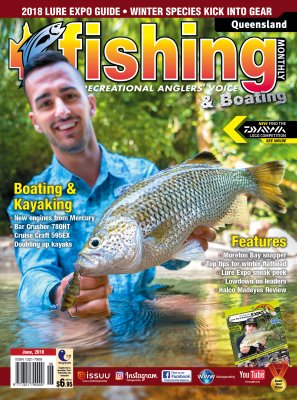Five tips for winter flathead fun by Steve Farmer
 Flathead are a popular and ideal fish for anglers new to lure fishing. They are often found in good numbers in areas that are easily accessible, even without a boat. The lizard can also be one of the easiest fish to catch on a lure, although, frustratingly, this isn't always the case. Like many anglers, flathead figured prominently in my earliest lure-tossing successes and I still enjoy walking the sand flats, flicking small lures in search of lizards.
Flathead are a popular and ideal fish for anglers new to lure fishing. They are often found in good numbers in areas that are easily accessible, even without a boat. The lizard can also be one of the easiest fish to catch on a lure, although, frustratingly, this isn't always the case. Like many anglers, flathead figured prominently in my earliest lure-tossing successes and I still enjoy walking the sand flats, flicking small lures in search of lizards.
Here are five tips for new and experienced lure fishers hoping to snare a flatty or two.
1: FISH LIGHT
Even large flathead can be fairly easily handled on relatively light tackle. They are clean fighters in mainly clear country and as such are unlikely to cut you off on a snag. In my experience it's the smaller lizards that are more likely to turn on a lively tussle, while the larger fish usually fight slow and steady. A 3-4kg spinning outfit comprising of a light rod around 2m long and a reel holding about 150m of line will do the job nicely. Add a heavier leader to protect against the flathead's spiky gill covers.
This sort of rig is lightweight and easy to fish with all day. It will fire small lightweight lures a fair distance, allowing you to cover more ground. If you are fishing the shallows or the fish are particularly spooky, being able to cast well ahead can make a major difference to your catch.
2: THE RIGHT LURE
Lures for flathead must be able to get to the bottom one way or another. Diving minnows or sinking lures such as weighted soft plastics or metal slugs will do the job. The flathead's hunting tactics of concealing itself in the sandy bottom to lay in wait for passing baitfish and crustaceans means you need to have your lure bouncing across the bottom to elicit the best response.
Hunting like this means the flathead doesn't expend a lot of energy when it feeds. A brief burst from its buried hideout to nail the unlucky baitfish is all that's required. This may be why even the smallest of lures (less than 5cm) can be very effective on even the largest of lizards.
3: SLOW DOWN
Retrieve speeds can make a big difference to your catches and flathead are no exception. Most of us are inclined to crank the reel handle a little too fast and I know I regularly have to remind myself to slow down. I recall one particular day I was flushing fish after fish, but couldn't raise a single strike - until I slowed my retrieve and quickly landed a couple of quality keepers.
The only thing to be aware of is that you don't slow to the point where your floating minnows are rising well clear of the bottom. Ideally a slow, stop/start, jerking retrieve will have your lures skipping erratically across the flats, sending up puffs of sand whenever they touch the bottom, just like a classic, wounded baitfish.
I remember one clued up angler who took the slow retrieve tactic to the extreme. It was late afternoon as he ambled down to the water's edge and fired his Cotton Cordell Spot (a sinking lure) as far as he could across the inlet. He made himself comfortable in the soft sand of the beach before casually cranking in a metre or so of line every couple of minutes. That's all. And it worked. He had fresh flathead for dinner that night while everyone else went home to dig out the can opener.
4: LOOK FOR STRUCTURE
Just because flathead roam mostly on the open sand flats doesn't mean they aren't drawn to what structure there is. A snag or weed bed in the middle of a sand flat is like an oasis in the middle of a desert, providing shelter for nervous baitfish. So where else would a hungry flathead want to be? It pays